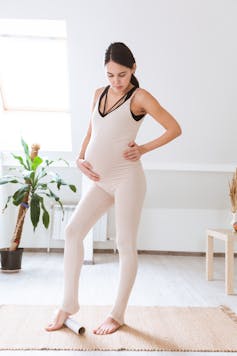Along with the rest of the body, being pregnant can have a huge impact on feet. More than half of expectant mothers experience some form of foot problem during pregnancy. But foot issues are often neglected, with other medical aspects of pregnancy given more attention. The good news is, however, that many of these conditions can be effectively and safely treated without medication.
Listed below are the four most common pregnancy-related foot problems along with simple and effective advice on how to manage them. Nine months is a long time to be uncomfortable, but by making simple changes expectant mothers can be back on their feet in no time.
1. Collapsed arches
Gaining weight quickly, particularly during the first few months of pregnancy, can have an impact on foot structure, and cause the arch to collapse. The body also releases a hormone called relaxin during pregnancy, which allows the pelvis to open for delivery. But this can have the effect of relaxing ligaments in the feet and ankles too, making them more flexible, and contributing to the appearance of flat feet. This can be painful as tendons, ligaments and muscles in the feet and legs all have to work harder to help support the foot and may become damaged due to overuse.
To relieve the effects of collapsed arches, wear comfortable footwear, ideally with a firm heel, a cushioned innersole and either a strap, laces, or Velcro. This will keep the foot stable and help to support the arch. It may be necessary to support the arch with insoles that fit inside your shoes – a podiatrist will be able to advise you on these. They may be temporary but can give a great deal of relief.
2. Swelling
It’s normal to get some swelling in pregnancy, particularly in your ankles and feet. It is often worse at the end of the day or if you have been standing or sitting for long periods. One reason for swelling is that as the baby grows, the uterus can put pressure on veins in the pelvis, slowing down the return of blood to the heart. This can lead to blood accumulating in the small vessels of the foot, and fluid leaking into the surrounding tissues causing swelling (known as oedema).
To reduce swelling pregnant women should try not to sit or stand for long periods of time, keep feet elevated whenever possible, and avoid crossing the legs. Staying active with regular exercise such as walking and swimming helps too. These low impact activities keep the blood circulating around the body.
Expectant mothers may also find that they will need to wear a shoe size bigger than they are used to. As a rule, there should be a one centimetre gap between the longest toe and the end of the shoe. Feet tend to swell during the day, so if buying new shoes, do it later in the afternoon when your feet are at their largest.
3. Foot pain
Common sites of pain include the heel and around the arch of the foot (in the plantar fascia, a band of connective tissue that helps support the arch of the foot), where a condition known as plantar fasciitis may be diagnosed when the tissue becomes irritated. There is also a risk that areas of high pressure can result in corns and calluses developing.

UvGroup/Shutterstock
Along with correct footwear, daily stretching of the plantar fascia can also help relieve pain. To do this, place a towel on the pad right under your toes, pull back and hold for 20-30 seconds. Alternatively, you can roll a cold can of drink under the arch of your foot. Stretching the calf muscle with a wall stretch can also help too. Place two hands on a wall, bend your right knee, push your left heel into the ground and hold for 30 seconds. Switch sides and repeat.
4. Dry and cracked heels
Hormonal changes cause your skin to lose elasticity and moisture as it stretches and tightens, which can result in dry skin and cracking around the heels. Maintaining a good daily skin care regime which includes applying a moisturising cream once a day can reduce moisture loss from the skin. For particularly dry skin around the heels using a moisturiser that contains urea may be more effective to soften the skin. If you are finding it difficult to reach your feet to apply the cream, try applying a little of the cream onto a sponge, placing it on the floor and then rubbing your heel into it. This method works the cream deep into the skin too.
Pregnancy and pending motherhood should be a joyous experience, without painful foot issues. If your foot problems persist, healthcare professionals such as a podiatrists can advise you on potential treatments such as physical therapy and insoles, as well as give advice on footwear. They can also treat corns, calluses and carry out minor ingrowing toenail procedures. Ultimately though if you have any pregnancy-related concerns please seek advice from your GP or midwife.
Craig Gwynne, Lecturer in Podiatry, Cardiff Metropolitan University
This article is republished from The Conversation under a Creative Commons license. Read the original article.

